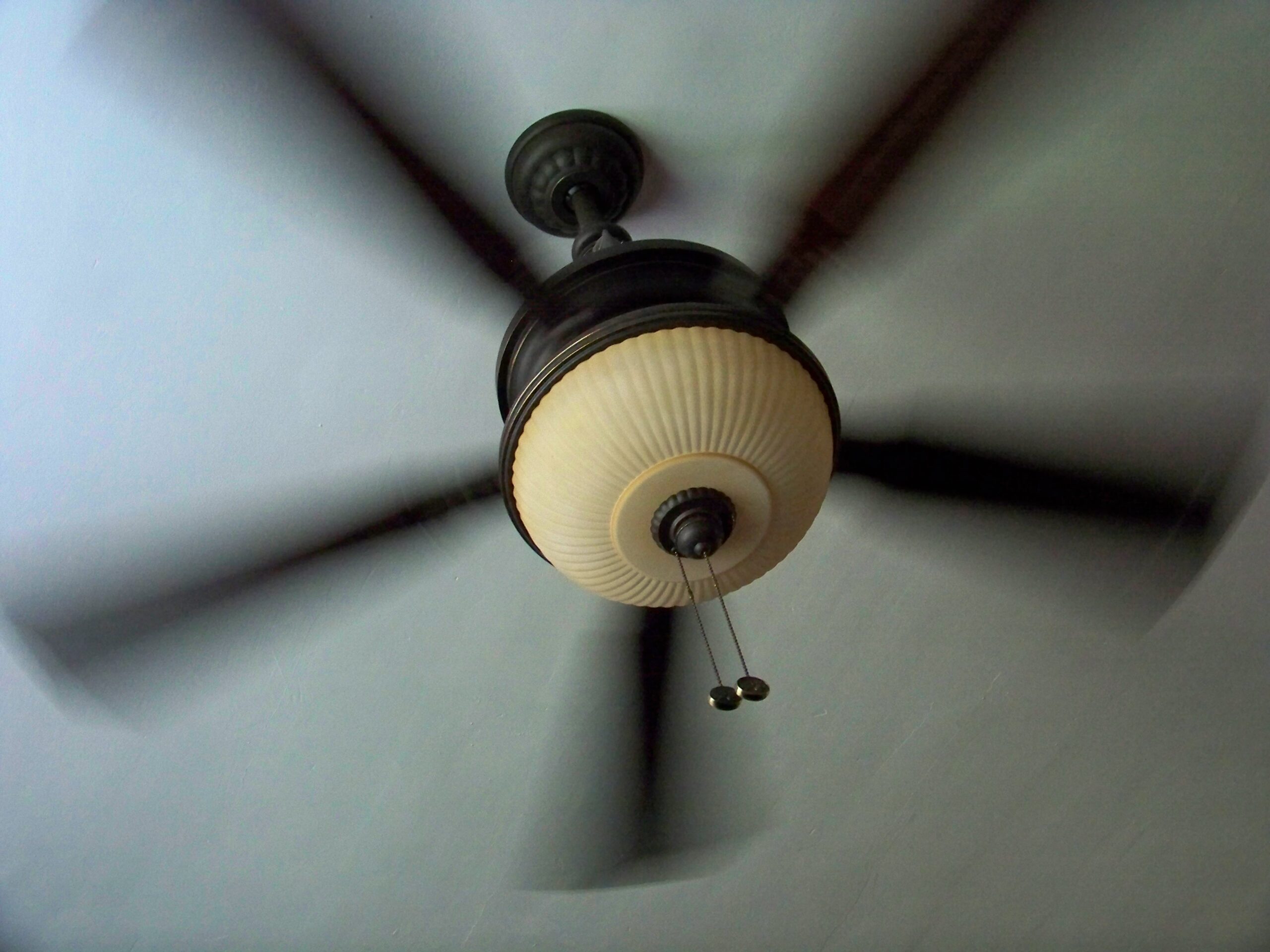Ceiling fans are essential household appliances that enhance comfort by circulating air in a room. However, over time, they may develop issues that compromise their performance. This comprehensive guide provides detailed, step-by-step instructions to help you diagnose and fix common problems with ceiling fans.
Emphasizing Safety
Before beginning any repair work, prioritizing safety is crucial. Ceiling fans are connected to electrical circuits, and mishandling them can lead to electric shocks or other injuries. Always take necessary precautions to ensure a safe working environment.
Gathering Tools and Equipment
Ensure you have the following tools and equipment ready: screwdrivers (both Phillips and flathead), a voltage tester, pliers, wire strippers, a ladder, electrical tape, and any replacement parts you might need. Having these tools on hand will facilitate the repair process.
Disconnecting Power
Before working on the ceiling fan, turn off the power at the circuit breaker. To verify that the power is indeed off, use a voltage tester on the fan’s wiring.
Understanding Common Issues
Understanding the specific problem is the first step to fixing your ceiling fan. Common issues include the fan not turning on, wobbling, making noise, operating at only one speed, or having lights that do not work.
Conducting a Visual Inspection
Perform a thorough visual inspection to identify any obvious issues such as loose screws, disconnected wires, or visible damage. This initial check can often pinpoint the problem area.
Addressing Electrical Issues
When the fan doesn’t turn on, start by checking the circuit breaker to ensure it hasn’t tripped. If it has, resetting it may resolve the issue. If the breaker is fine, use a voltage tester to check for power at the fan’s wiring. If no power is detected, the problem might lie within the wiring in your home. If power is present, proceed to inspect the fan’s wiring connections.
Sometimes, the wall switch controlling the fan might be faulty. To replace the switch, first turn off the power. Remove the switch cover plate, unscrew the switch, and pull it out. Disconnect the wires from the old switch and connect them to a new one. Secure the new switch in place and replace the cover plate.
Fixing Mechanical Issues
Loose screws can cause the fan to wobble or make noise. Check and tighten all screws, including those on the fan blades, mounting bracket, and downrod. If the fan continues to wobble, it may need balancing. Use a fan balancing kit and attach the balancing clip to the edge of a blade. Turn on the fan and observe the wobble. Move the clip to different blades and positions until the wobble decreases. Once you find the optimal position, apply balancing weights to the top of the blade where the clip reduces the wobble the most.
A noisy fan might require lubrication. Check your fan’s manual to see if it has oil ports. If it does, add a few drops of oil to the motor. If not, the motor may be sealed and might need professional servicing.
Resolving Speed Control Issues
If your fan operates at only one speed, the capacitor may be faulty. To replace it, first turn off the power. Remove the fan’s housing to access the capacitor, noting the wiring configuration. Disconnect the old capacitor and connect the new one, then reassemble the fan.
Addressing Light Issues
If the lights on your fan don’t work, start by checking the bulbs. Replace any burnt-out bulbs with new ones. If this doesn’t resolve the issue, check the light kit wiring. Turn off the power, remove the light kit from the fan, and check the wiring connections to ensure they are secure. Replace any faulty wires or components as needed.
Advanced Troubleshooting Techniques
In some cases, the motor itself may be faulty and require replacement. This is a more complex repair that may necessitate professional assistance. If you feel confident in your skills, start by turning off the power. Disconnect the wiring and remove the fan from the ceiling. Disassemble the fan to access the motor, remove the old motor, and install the new one. Reassemble the fan and reconnect the wiring.
If your fan uses a remote control and it’s not working, check the batteries in the remote. Ensure the remote and receiver are paired correctly. If these steps don’t resolve the issue, replacing the remote control may be necessary.
Maintenance Tips for Longevity
Regular maintenance can extend the life of your ceiling fan. Keep your fan clean to ensure optimal performance. Dust the blades regularly and clean the motor housing with a damp cloth. Periodically check and tighten all screws to prevent wobbling and noise. Inspect the wiring occasionally to ensure there are no loose or damaged connections.
Knowing When to Call a Professional
While many ceiling fan issues can be resolved with basic troubleshooting and repairs, some situations require professional help. Complex electrical issues beyond your expertise, motor replacements, and ensuring warranty considerations are all instances where calling a professional is advisable. If your fan is still under warranty, contact the manufacturer for repairs or replacements to avoid voiding the warranty.
What should I do before starting any ceiling fan repair? Always turn off the power at the circuit breaker to ensure safety and prevent electric shocks.
What tools do I need for ceiling fan repair? You will need screwdrivers (both Phillips and flathead), a voltage tester, pliers, wire strippers, a ladder, electrical tape, and any replacement parts.
Why is my ceiling fan not turning on? The issue could be a tripped circuit breaker, faulty wiring, or a defective wall switch.
How do I check if the circuit breaker has tripped? Locate your home’s circuit breaker panel and look for a switch that is not aligned with the others. Flip it back to the “on” position if it’s tripped.
How do I test the wiring of my ceiling fan? Use a voltage tester to check for power at the fan’s wiring connections.
What should I do if there is no power at the ceiling fan wiring? If there is no power, the problem may lie within the home’s wiring, requiring further inspection or an electrician’s help.
How can I fix a faulty wall switch? Replace the wall switch by turning off the power, removing the switch cover plate, unscrewing the switch, disconnecting the wires, and connecting them to a new switch.
Why is my ceiling fan wobbling? The fan may have loose screws, unbalanced blades, or an improperly mounted bracket.
How can I fix loose screws on my ceiling fan? Tighten all screws on the fan blades, mounting bracket, and downrod using a screwdriver.
How do I balance a wobbly ceiling fan? Use a fan balancing kit, attach the balancing clip to the edge of a blade, turn on the fan, and move the clip until the wobble decreases. Apply balancing weights accordingly.
What causes a ceiling fan to make noise? Noise can be due to loose screws, unbalanced blades, or a need for lubrication.
How can I lubricate my ceiling fan? Check the fan’s manual for oil ports. If available, add a few drops of oil to the motor.
Why does my ceiling fan operate at only one speed? A faulty capacitor often causes this issue.
How do I replace a faulty capacitor? Turn off the power, remove the fan’s housing, note the wiring configuration, disconnect the old capacitor, and connect the new one.
Why are the lights on my ceiling fan not working? The issue could be burnt-out bulbs, faulty wiring, or a defective light kit.
How do I check if the bulbs are the problem? Replace the current bulbs with new ones to see if the lights start working.
How do I inspect the light kit wiring? Turn off the power, remove the light kit, and check the wiring connections for security and any visible damage.
What should I do if the ceiling fan motor is faulty? Consider replacing the motor, which may require professional assistance if you are not confident in your skills.
How do I replace a ceiling fan motor? Turn off the power, disconnect the wiring, remove the fan, disassemble it to access the motor, remove the old motor, install the new one, reassemble the fan, and reconnect the wiring.
Why is my ceiling fan remote control not working? The problem could be dead batteries, incorrect pairing, or a defective remote.
How do I replace the remote control batteries? Open the battery compartment on the remote, remove the old batteries, and insert new ones.
How do I pair the remote control with the ceiling fan? Follow the manufacturer’s instructions for pairing, which typically involves pressing specific buttons on the remote and the fan receiver.
What should I do if the remote control is still not working? Replace the remote control if replacing batteries and re-pairing doesn’t resolve the issue.
How often should I clean my ceiling fan? Clean the fan blades and motor housing regularly, at least once every few months, to ensure optimal performance.
What’s the best way to clean ceiling fan blades? Use a microfiber cloth or a damp cloth to wipe down the blades, removing dust and grime.
How can I prevent my ceiling fan from wobbling? Regularly check and tighten all screws and ensure the fan is properly balanced.
How do I check the wiring periodically? Turn off the power and visually inspect the wiring for any loose or damaged connections.
When should I call a professional for ceiling fan issues? Call a professional if you encounter complex electrical problems, need to replace the motor, or want to avoid voiding a warranty.
What are the warranty considerations for ceiling fan repairs? If your fan is under warranty, contact the manufacturer for repairs or replacements to avoid voiding the warranty.
How can I ensure my ceiling fan operates efficiently? Regular maintenance, such as cleaning, tightening screws, and checking wiring, helps maintain optimal performance.
What is the purpose of a voltage tester in ceiling fan repair? A voltage tester ensures there is no electrical current before handling the fan’s wiring, preventing electric shocks.
Can I use any type of lubricant for my ceiling fan? Use the lubricant specified in your fan’s manual, usually a light machine oil.
How do I know if the capacitor is the problem with my ceiling fan? If the fan operates at only one speed or not at all, the capacitor is likely the culprit and should be tested or replaced.
How can I identify a loose wire in my ceiling fan? Visually inspect all wiring connections for any that appear loose or disconnected, and use a voltage tester to check for power continuity.
What should I do if my ceiling fan hums but doesn’t spin? This could indicate a problem with the motor or capacitor. Inspect these components and replace if necessary.
How do I safely remove a ceiling fan for repair? Turn off the power, disconnect the wiring, and carefully unscrew the fan from the mounting bracket, supporting the fan to prevent it from falling.
Can I repair a ceiling fan without turning off the power? No, always turn off the power to avoid the risk of electric shock.
What should I do if my ceiling fan blades are damaged? Replace the damaged blades with new ones that match the fan’s specifications.
How do I install a new light kit on my ceiling fan? Turn off the power, remove the old light kit, connect the wiring of the new light kit, and secure it in place.
Why does my ceiling fan make a clicking noise? Clicking noises are often caused by loose screws or unbalanced blades. Check and tighten all screws and balance the blades if necessary.
How can I improve the airflow of my ceiling fan? Ensure the fan is running in the correct direction for the season (counterclockwise in summer, clockwise in winter) and keep the blades clean and balanced.
What type of screwdriver should I use for ceiling fan repair? Both Phillips and flathead screwdrivers are commonly needed for various screws on a ceiling fan.
How do I fix a ceiling fan that spins too slowly? Check and replace the capacitor if necessary, and ensure the blades are clean and properly balanced.
What should I do if my ceiling fan smells like it’s burning? Immediately turn off the power and inspect for any signs of burning or overheating components. This may require professional attention.
How can I extend the lifespan of my ceiling fan? Regular maintenance, such as cleaning, tightening screws, lubricating the motor, and checking wiring, will help extend the lifespan of your ceiling fan.
Why does my ceiling fan make a grinding noise? A grinding noise can indicate that the motor bearings are worn out or need lubrication. Check the motor for any visible wear and add lubricant if necessary, following the manufacturer’s guidelines.
How do I replace a broken pull chain on my ceiling fan? To replace a broken pull chain, first turn off the power, then remove the fan housing to access the switch. Disconnect the old chain from the switch and attach the new one. Reassemble the fan housing and turn the power back on.
Why does my ceiling fan reverse direction on its own? This could be due to a faulty reverse switch. Check the switch on the fan housing and ensure it is set properly. If the issue persists, the switch may need to be replaced.
How do I adjust the angle of the ceiling fan blades? Adjusting the angle of the blades may involve slightly bending the blade brackets. Be cautious and make small adjustments, checking for balance and wobble after each adjustment.
What should I do if my ceiling fan stops working after a storm? If your ceiling fan stops working after a storm, there could be an issue with the electrical supply. Check the circuit breaker and wiring for any damage. If the problem persists, consult an electrician.
How can I fix a ceiling fan that turns off by itself? A ceiling fan that turns off by itself could have a loose wire or a faulty motor. Check the wiring connections for security and inspect the motor for any signs of damage.
Why is my ceiling fan slow to start? A slow-starting ceiling fan might have a failing capacitor. Inspect and replace the capacitor if necessary, following the manufacturer’s instructions.
Can I replace the blades on my ceiling fan with a different style? You can replace the blades with a different style as long as they are compatible with your fan model. Ensure the new blades match the size and weight specifications of your fan.
How do I prevent dust buildup on my ceiling fan? To prevent dust buildup, clean the fan blades regularly with a microfiber cloth. Additionally, you can use an anti-static spray on the blades to reduce static cling, which attracts dust.
Why does my ceiling fan make a high-pitched noise? A high-pitched noise can be caused by a loose component or a failing motor. Tighten any loose screws and inspect the motor for wear. Lubricate the motor if necessary or consider replacing it if the noise persists.
Conclusion
Fixing a ceiling fan can range from simple tasks like tightening screws to more complex repairs like replacing the motor. By following this comprehensive guide, you can diagnose and fix most common issues with your ceiling fan, ensuring it operates smoothly and efficiently.
Always prioritize safety and consult a professional if you are unsure about any repair. With the right approach, you can restore your ceiling fan to its optimal performance and enjoy the comfort it provides for years to come.



